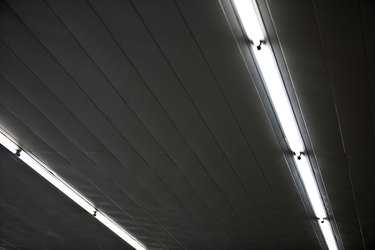
Fluorescent lights have an advantage in energy efficiency over incandescent lighting. Fluorescent lights can produce 50 to 100 lumens/watt, compared to about 15 lumens/watt for incandescent bulbs, according to according to Georgia State University. Fluorescent lights activate mercury, which then causes the phosphor coating on the bulb's interior to glow. Some factors, however, may cause the lights to come on slowly.
Warm-up Period
Video of the Day
Because of the manner in which fluorescent lights operate, they generally take longer to start up than incandescent lights. Although improvements in technology have reduced the time is takes for the ballast (the device that starts and controls the current in the bulb when it is turned on) to produce enough electricity to excite the gas inside the bulb, the bulbs still require a short warm-up period before they reach full brightness, according to GE Consumer and Industrial Lighting. This is why fluorescent lighting in a garage may appear dim when it is first turned on.
Video of the Day
Cold Weather
Fluorescent lights do not function well in cold areas, such as a garage. They may be slow to come on, and remain dim once they do begin to glow. The lower the temperatures drops, the longer it may take for the bulb to illuminate. Using enclosed fixtures that provide insulation or jacketed lights, which have a light transparent jacket surrounding the bulb with a fluid-filled chamber between the bulb and jacket, may help the fluorescent lights to come on more quickly during cold weather.
Ballast
While fluorescent lights are much more efficient than incandescent bulbs, they are harder to control. The electrical discharge which excites the mercury vapor must be started promptly, and the current requires control to keep it from rising too high. The ballast handles these functions. The job of the ballast is to cause delays in tube fixtures; an older or malfunctioning ballast may cause too much delay, and the light may not start immediately.
Starter
Fluorescent lighting in a garage may take longer to light because the starter, a small metallic cylinder that plugs into a socket on the light fixture's frame, may be worn out or malfunctioning. Although newer fluorescent lighting systems do not have starters, a fixture over 15 years old most likely will have one. The purpose of the starter is to send a delayed shot of electricity to the gas within the bulb, allowing the gas to become ionized and able to conduct electricity. A defective starter may cause the bulb to delay lighting, and the light may flicker once it is on.